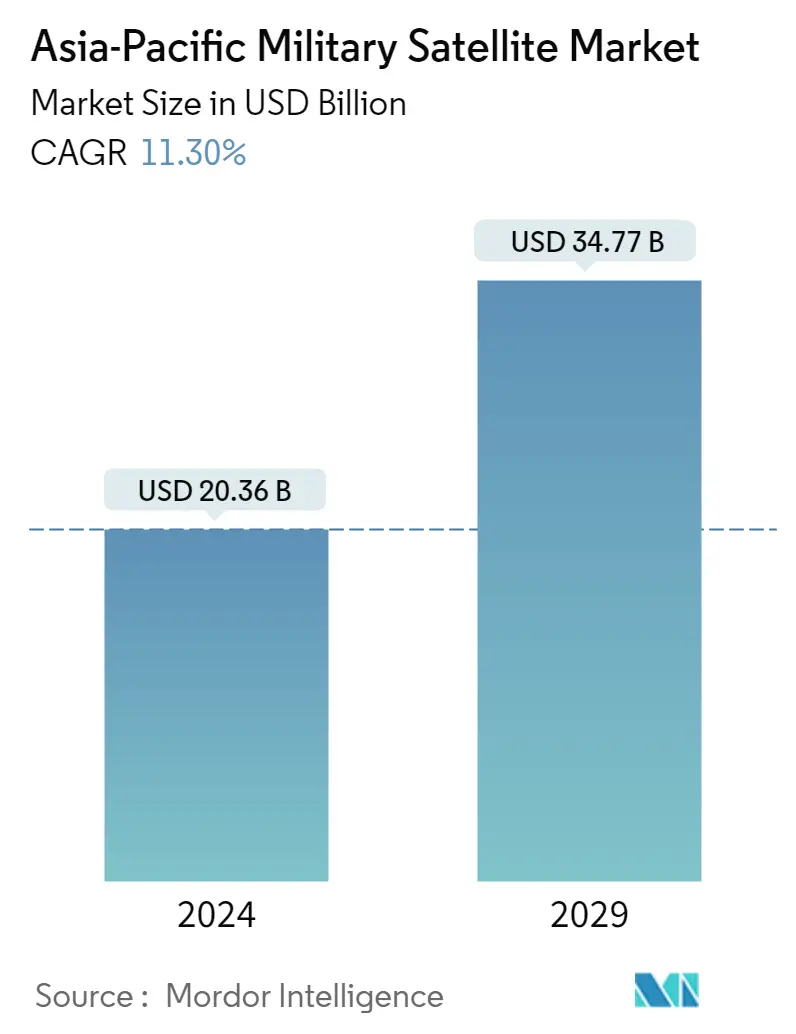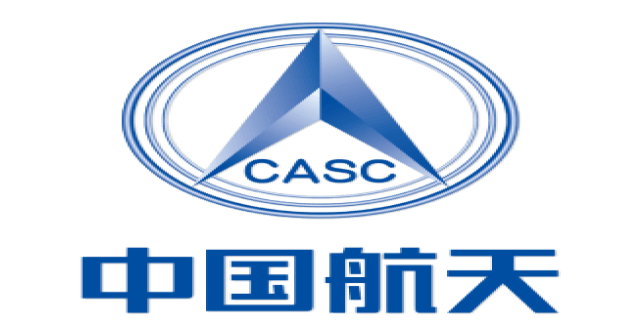Market Size of asia-pacific military satellite Industry

|
|
Study Period | 2017 - 2029 |
|
|
Market Size (2024) | USD 20.36 Billion |
|
|
Market Size (2029) | USD 34.77 Billion |
|
|
Largest Share by Orbit Class | LEO |
|
|
CAGR (2024 - 2029) | 11.30 % |
|
|
Largest Share by Country | South Korea |
Major Players |
||

|
||
|
*Disclaimer: Major Players sorted in no particular order |
Asia-Pacific Military Satellite Market Analysis
The Asia-Pacific Military Satellite Market size is estimated at USD 20.36 billion in 2024, and is expected to reach USD 34.77 billion by 2029, growing at a CAGR of 11.30% during the forecast period (2024-2029).
20.36 Billion
Market Size in 2024 (USD)
34.77 Billion
Market Size in 2029 (USD)
12.71 %
CAGR (2017-2023)
11.30 %
CAGR (2024-2029)
Largest Market by Satellite Mass
68.18 %
value share, above 1000kg, 2022
Large satellites have a higher demand owing to their applications, such as satellite radio, communications, remote sensing, planetary security, and weather forecasting.
Largest Market by Satellite Subsystem
80.28 %
value share, Propulsion Hardware and Propellant, 2022
The demand for these propulsion systems is driven by the launch of mass satellite constellations into space. They are used for transferring the spacecraft to the orbit.
Largest Market by Orbit Class
84.81 %
value share, LEO, 2022
LEO satellites are increasingly being adopted in modern communication technologies. These satellites serve an important role in Earth observation applications.
Largest Market by Application
83.28 %
value share, Earth Observation, 2022
Earth observation satellites are used for weather forecasting, forestry mapping, and pollution monitoring. The growing adoption of VAS by private companies and organizations is likely to fuel the growth of satellite-based Earth observation.
Leading Market Player
95 %
market share, China Aerospace Science and Technology Corporation (CASC), 2022

China Aerospace Science and Technology Corporation is the leading player in the market. CASC offers a wide range of launch vehicles and adopts a competitive pricing strategy to attract customers across the world.
LEO satellites driving the demand by occupying a major share of 84% in 2029
- Asia-Pacific has seen a significant increase in the demand for military satellites to accommodate a wide range of satellite orbits, including low Earth orbit (LEO), medium Earth orbit (MEO), and geostationary Earth orbit (GEO). This demand has been driven by the growing need for satellite-based communication, navigation, and remote sensing services.
- LEO satellites have become increasingly popular for a wide range of applications, including Earth observation, weather forecasting, and communication. The demand for LEO satellites has been particularly strong in China, where companies such as Spacety and Chang Guang Satellite Technology Co. Ltd offer satellite buses for LEO missions. China has been active in this region with the launch of the Gao Fen series satellites.
- MEO satellites have become increasingly important for global navigation and positioning services such as GPS and Galileo. In the region, China has been a leader in this area with the launch of the BeiDou navigation system.
- GEO satellites are particularly important for communication and broadcasting services, such as television and the Internet. The demand for GEO satellites has been particularly strong in India, where companies such as ISRO and Antrix Corporation Ltd have been developing advanced satellite buses for communication missions. China has also been investing heavily in GEO satellites, with the launch of the Zhongxing series of communication satellites.
Asia-Pacific Military Satellite Industry Segmentation
10-100kg, 100-500kg, 500-1000kg, Below 10 Kg, above 1000kg are covered as segments by Satellite Mass. GEO, LEO, MEO are covered as segments by Orbit Class. Propulsion Hardware and Propellant, Satellite Bus & Subsystems, Solar Array & Power Hardware, Structures, Harness & Mechanisms are covered as segments by Satellite Subsystem. Communication, Earth Observation, Navigation, Space Observation, Others are covered as segments by Application.
- Asia-Pacific has seen a significant increase in the demand for military satellites to accommodate a wide range of satellite orbits, including low Earth orbit (LEO), medium Earth orbit (MEO), and geostationary Earth orbit (GEO). This demand has been driven by the growing need for satellite-based communication, navigation, and remote sensing services.
- LEO satellites have become increasingly popular for a wide range of applications, including Earth observation, weather forecasting, and communication. The demand for LEO satellites has been particularly strong in China, where companies such as Spacety and Chang Guang Satellite Technology Co. Ltd offer satellite buses for LEO missions. China has been active in this region with the launch of the Gao Fen series satellites.
- MEO satellites have become increasingly important for global navigation and positioning services such as GPS and Galileo. In the region, China has been a leader in this area with the launch of the BeiDou navigation system.
- GEO satellites are particularly important for communication and broadcasting services, such as television and the Internet. The demand for GEO satellites has been particularly strong in India, where companies such as ISRO and Antrix Corporation Ltd have been developing advanced satellite buses for communication missions. China has also been investing heavily in GEO satellites, with the launch of the Zhongxing series of communication satellites.
| Satellite Mass | |
| 10-100kg | |
| 100-500kg | |
| 500-1000kg | |
| Below 10 Kg | |
| above 1000kg |
| Orbit Class | |
| GEO | |
| LEO | |
| MEO |
| Satellite Subsystem | |
| Propulsion Hardware and Propellant | |
| Satellite Bus & Subsystems | |
| Solar Array & Power Hardware | |
| Structures, Harness & Mechanisms |
| Application | |
| Communication | |
| Earth Observation | |
| Navigation | |
| Space Observation | |
| Others |
Asia-Pacific Military Satellite Market Size Summary
The Asia-Pacific military satellite market is experiencing substantial growth, driven by an increasing demand for satellite-based communication, navigation, and remote sensing services. The region is witnessing a surge in the deployment of satellites across various orbits, including low Earth orbit (LEO), medium Earth orbit (MEO), and geostationary Earth orbit (GEO). LEO satellites are gaining popularity for applications such as Earth observation and communication, with significant activity in China. MEO satellites are crucial for global navigation systems, with China's BeiDou system leading the charge. GEO satellites are essential for communication and broadcasting, with India and China making significant advancements in this area. The market is characterized by the development of miniature satellites, which offer cost-effective solutions and sophisticated mission capabilities. The demand is primarily driven by countries like China, Japan, South Korea, and India, which are at the forefront of small satellite manufacturing.
The Asia-Pacific region is enhancing its space infrastructure, with countries like China, India, Japan, and South Korea making significant investments in satellite production capabilities. China's space exploration priorities include expanding civil space infrastructure, while Japan's space budget reflects substantial investment in various space activities. India is a global leader in third-party launch services, and South Korea is gradually advancing its space program despite challenges in technology transfer. Southeast Asian countries are also investing in space technology, with Indonesia securing funding for satellite fabrication. The market is fairly consolidated, with major players like Airbus SE, China Aerospace Science and Technology Corporation, Innovative Solutions in Space BV, Mitsubishi Heavy Industries, and Thales dominating the landscape. Recent contracts and satellite launches in the region highlight ongoing advancements and collaborations in military satellite development.
Asia-Pacific Military Satellite Market Size - Table of Contents
-
1. MARKET SEGMENTATION (includes market size in Value in USD, Forecasts up to 2029 and analysis of growth prospects)
-
1.1 Satellite Mass
-
1.1.1 10-100kg
-
1.1.2 100-500kg
-
1.1.3 500-1000kg
-
1.1.4 Below 10 Kg
-
1.1.5 above 1000kg
-
-
1.2 Orbit Class
-
1.2.1 GEO
-
1.2.2 LEO
-
1.2.3 MEO
-
-
1.3 Satellite Subsystem
-
1.3.1 Propulsion Hardware and Propellant
-
1.3.2 Satellite Bus & Subsystems
-
1.3.3 Solar Array & Power Hardware
-
1.3.4 Structures, Harness & Mechanisms
-
-
1.4 Application
-
1.4.1 Communication
-
1.4.2 Earth Observation
-
1.4.3 Navigation
-
1.4.4 Space Observation
-
1.4.5 Others
-
-
Asia-Pacific Military Satellite Market Size FAQs
How big is the Asia-Pacific Military Satellite Market?
The Asia-Pacific Military Satellite Market size is expected to reach USD 20.36 billion in 2024 and grow at a CAGR of 11.30% to reach USD 34.77 billion by 2029.
What is the current Asia-Pacific Military Satellite Market size?
In 2024, the Asia-Pacific Military Satellite Market size is expected to reach USD 20.36 billion.

